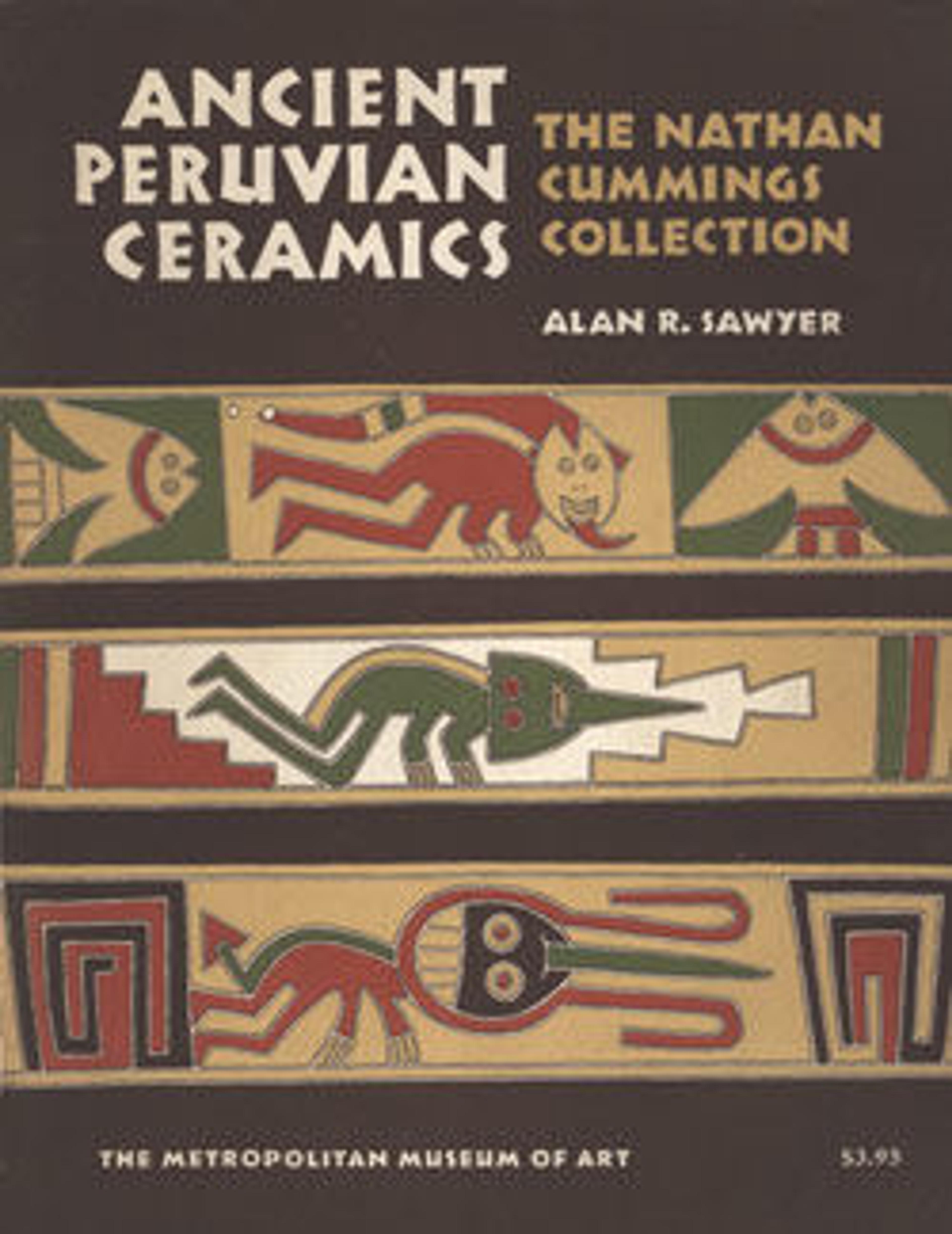Figure Bottle
This ceramic bottle modeled in the shape of a man was painted with polychrome slips (a suspension of clay in water) indicating his garments, cap, and other details. Made by potters of the Nasca culture on Peru’s south coast, the hollow body of the vessel has a cylindrical spout emanating from the back and connecting via a thin bridge to the rear of the head. The figure is depicted wearing a woven cap in maroon and black with a white band along the lower edge. Multiple black threads hang down from the cap along the sides and back of the head. The figure’s primary garment features red and black stripes on a white background. The figure holds what appear to be a striped cloth in his proper right hand, and a thin black spear or baton that is shown diagonally across the front of the figure descending from the left shoulder to the lower right of the textile wrap (see Lapiner 1976: 205, Fig. 486, for an example of a Nasca figure with a spear). The figure appears to have a small beard as well as facial decorations on his checks, forehead, and on both sides of his eyes. A slight bulge in his left cheek may indicate a quid of coca, cultivated plants of the Erythroxylaceae family whose leaves were chewed as a mild stimulant. The upper jaw seems to be recessed or missing and the nose reduced to simple nostrils. This may indicate either advanced leishmaniasis or a craniofacial dysmorphia.
The Nasca inhabited the fertile coastal valleys of southern Peru and were great innovators in both ceramic technology and textile fabrication. Nasca potters were early developers of the use of polychrome slips and deployed them to depict animals, plants, deities, and individuals performing different tasks. Textile production, which was advanced in all cultures in ancient Peru, reached a very high level in the Nasca period, particularly the variety of techniques, materials, and overall quality. Although this individual wears a rather simple wrap, other textiles used embroidery, feathers, tie-dye, and other variations. The arid desert environment of the Peruvian south coast has permitted the preservation of many of these weavings (see, for example, works in the Met’s collection, including 28.171.13 and 29.146.23).
References
Lavalle, José Antonio and José Alejandro González García, series directors. Arte textil del Perú. Lima, Peru: Industria Textil Piura, 1988-1989.
Lavalle, José Antonio. Nazca. Culturas Precolombinas. Lima, Peru: Banco de Crédito del Perú, 1989.
Pardo, Cecilia, and Peter Fux, editors. Nasca. Exh. cat. Lima, Peru: Asociación Museo de Arte de Lima; Zürich, Switzerland: Museo Rietberg, 2017. Proulx, Donald A. A Sourcebook of Nasca Ceramic Iconography: Reading a Culture through its Art. Iowa City: University of Iowa Press, 2006.
Rickenbach, Judith. Nasca: Geheimnisvolle Zeichen im alten Peru. Exh. cat. Zürich: Museum Rietberg, 1999.
The Nasca inhabited the fertile coastal valleys of southern Peru and were great innovators in both ceramic technology and textile fabrication. Nasca potters were early developers of the use of polychrome slips and deployed them to depict animals, plants, deities, and individuals performing different tasks. Textile production, which was advanced in all cultures in ancient Peru, reached a very high level in the Nasca period, particularly the variety of techniques, materials, and overall quality. Although this individual wears a rather simple wrap, other textiles used embroidery, feathers, tie-dye, and other variations. The arid desert environment of the Peruvian south coast has permitted the preservation of many of these weavings (see, for example, works in the Met’s collection, including 28.171.13 and 29.146.23).
References
Lavalle, José Antonio and José Alejandro González García, series directors. Arte textil del Perú. Lima, Peru: Industria Textil Piura, 1988-1989.
Lavalle, José Antonio. Nazca. Culturas Precolombinas. Lima, Peru: Banco de Crédito del Perú, 1989.
Pardo, Cecilia, and Peter Fux, editors. Nasca. Exh. cat. Lima, Peru: Asociación Museo de Arte de Lima; Zürich, Switzerland: Museo Rietberg, 2017. Proulx, Donald A. A Sourcebook of Nasca Ceramic Iconography: Reading a Culture through its Art. Iowa City: University of Iowa Press, 2006.
Rickenbach, Judith. Nasca: Geheimnisvolle Zeichen im alten Peru. Exh. cat. Zürich: Museum Rietberg, 1999.
Artwork Details
- Title: Figure Bottle
- Date: 4th–6th century
- Geography: Peru
- Culture: Nasca
- Medium: Ceramic, pigment
- Dimensions: H. 8 1/2 in. (21.59 cm)
- Classification: Ceramics-Containers
- Credit Line: Gift of Mr. and Mrs. Nathan Cummings, 1964
- Object Number: 64.228.65
- Curatorial Department: The Michael C. Rockefeller Wing
More Artwork
Research Resources
The Met provides unparalleled resources for research and welcomes an international community of students and scholars. The Met's Open Access API is where creators and researchers can connect to the The Met collection. Open Access data and public domain images are available for unrestricted commercial and noncommercial use without permission or fee.
To request images under copyright and other restrictions, please use this Image Request form.
Feedback
We continue to research and examine historical and cultural context for objects in The Met collection. If you have comments or questions about this object record, please contact us using the form below. The Museum looks forward to receiving your comments.
